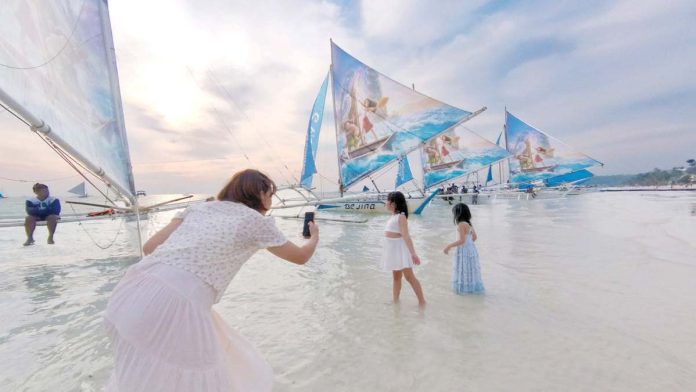
BY GEROME DALIPE IV
ILOILO City – A proposed 1.2-kilometer bridge aims to improve access to Boracay Island by connecting it directly to the mainland town of Malay, Aklan.
While the bridge is expected to enhance convenience for tourists and residents, it raises socioeconomic concerns, particularly for the livelihoods of local boatmen and boat owners who currently depend on ferrying passengers between Boracay and the mainland.
According to Godofredo Sadiasa, a consultant for the Caticlan Boracay Transport Multi-Purpose Cooperative (CBTMPC), the bridge would directly impact around 500 boatmen and 40 boat owners.
In his recent interview with Radyo Todo Aklan, Sadiasa said the boat services are not merely businesses but vital sources of livelihood for the workers.
The situation is further complicated by the financial commitments of CBTMPC.
Sadiasa revealed that the cooperative has outstanding bank debts resulting from compliance with the government’s boat modernization program.
CBTMPC invested in 48 fiberglass boats, each costing between P8 million and P10 million, amounting to nearly P500 million in total investment.
The modernization effort, intended to align with government mandates, now leaves the cooperative in a precarious financial position as the bridge project threatens to render their operations obsolete.
In 2021, the CBTMPC faced a significant shift in its operations when the wooden-hulled passenger boats they had long relied upon were phased out.
The termination of their Certificates of Public Convenience upon expiration compelled the CBTMPC to modernize their fleet, replacing the wooden boats with plastic-reinforced or fiber-reinforced plastic vessels, as mandated by the government.
The transition came at a substantial cost, with each new boat priced between P6.4 million and P10 million, adding to the cooperative’s financial burdens.
Despite these efforts to modernize and comply with regulations, the proposed construction of the Boracay bridge now threatens to render their upgraded fleet obsolete.
This amplifies the financial strain on CBTMPC, which is already grappling with significant investments and outstanding debts incurred during the modernization process.
The boatmen have expressed frustration with the government’s contradictory policies.
They criticized the push for boat modernization, which required significant financial investment to prevent job loss, only for their livelihoods to be jeopardized by the proposed Boracay bridge project.
In response to the looming threat, the CBTMPC has sought support from Aklan vice governor Reynaldo Quimpo.
The Sangguniang Panlalawigan (SP) of Aklan has begun drafting a position paper opposing the bridge’s construction.
Quimpo has publicly opposed the proposed Boracay bridge, citing several critical concerns in a Facebook post.
He pointed to the lack of proper consultation with local stakeholders and highlighted that the project violates a provincial ordinance enforcing a “one entry/exit policy” for Boracay Island. The policy is aimed at preserving and protecting the province’s valuable tourism assets.
Quimpo underscored the significant economic repercussions of the bridge’s construction. He noted the severe impact on the sea transport sector, particularly the P368 million investment made by the cooperative under the sea craft modernization program.
Additionally, the province stands to lose approximately P990,000 in revenues daily, amounting to about P361 million annually.
The Malay Municipal Council has clarified its stance on the proposed Boracay bridge, stating in a resolution dated October 10 that it has not received any formal proposal or application from an investor regarding the project’s construction.
The local council reassured the public of its commitment to transparency in handling infrastructure and investment proposals.
The town council emphasized that should a proposal be submitted, the local government would conduct a thorough evaluation process.
This would include adherence to established procedures and extensive consultations with key stakeholders in Malay to ensure that all concerns are addressed.
Once completed, the Boracay bridge is expected to help manage the island’s environmental carrying capacity and ease the pressures due to overcrowding and overuse of existing facilities.
The proposed Boracay bridge, valued at P8 billion, is a flagship project under the P4.6-billion Public-Private Partnership (PPP) budget of the Department of Public Works and Highways (DPWH) for 2025.
Negotiations for San Miguel Holdings Corporation’s (SMC) unsolicited offer for the Boracay bridge project began on February 21, 2024. SMC, which operates the Boracay Airport in Panay through its concession-holder TransAire Development Holdings Corp., plans to undertake the project under a build-operate-transfer (BOT) scheme.
Under the BOT arrangement, SMC would finance, construct, and operate the bridge for a specified period before transferring ownership to the government.
This public-private partnership model allows private investors to recover costs and generate profit through operational revenues during the concession period.
The project entails constructing a 1.2km limited-bridge access system with facility hubs connecting Boracay Island with Caticlan, Malay.
The scope of the project includes the financing, design, construction, operation, and maintenance by SMC of infrastructure between Boracay Island and Caticlan, Malay, according to DPWH.
Its proposed facilities include providing and operating a limited-access toll-bridge system, carriage of pedestrian lanes, bikeways, power, telecommunication, water supply, sewerage, utility lines, and public land transportation services.
The proposed bridge will be a two-way two-lane bridge with provision for a bike lane and sidewalk on each side.
The proposed bridge aims to manage the environmental carrying capacity of the Boracay.
It also intends to open up a new all-weather access for vehicles and pedestrians, thereby, encouraging people to consider alternative accommodations and activity centers on the mainland.
Likewise, the project hopes to free up Boracay Island from pressures due to overcrowding and overuse of existing facilities, which ultimately produce adverse environmental impacts.
Apart from improving the connectivity between Boracay Island and the mainland, the project will further enhance tourism infrastructure, support economic growth, and address logistical challenges associated with accessing Boracay Island./PN





